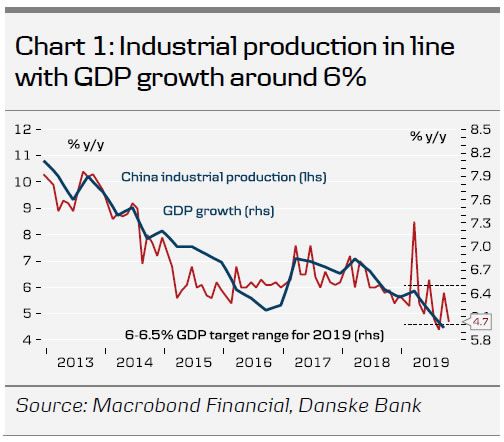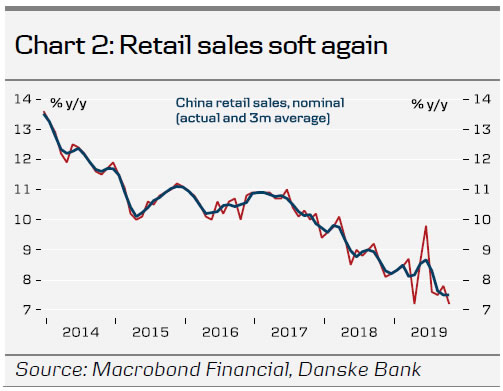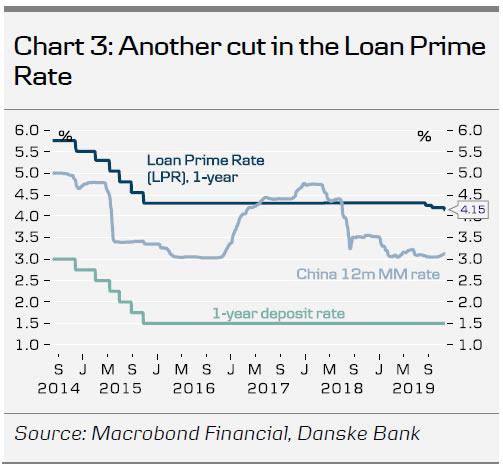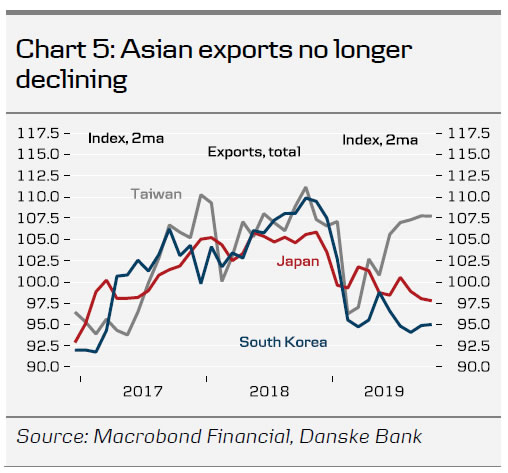- US-China phase one deal challenged by Trump’s reluctance to roll back tariffs and US demand for big Chinese agricultural purchases
- Economic data is mixed but we still look for a moderate rebound in activity
- China launches new plan to boost manufacturing technology. China doubles down on climbing the value chain and developing core technologies
Trade talks hit bumps in the road
Around a month ago, it seemed like a phase one deal would be easy to agree on and it was scheduled to be signed around 16-17 November when the APEC meeting in Chile was supposed to take place. While the APEC meeting was cancelled, the message at the time was that the US and China aimed for another place of signing around the same dates. The exercise of making a phase one deal was supposed to be simple: put all you agree on into a deal and leave the rest for later. However, the two sides are still struggling to get a phase one deal done. US President Donald Trump this week threatened to raise tariffs in December if China did not give him a good phase one deal. The standoff seems to be between China’s demands for a roll-back of tariffs, and US demands on how many agricultural goods China should buy in return. China’s chief negotiator Vice Premier Liu He said in Beijing he was ‘cautiously optimistic ‘ about reaching a phase one deal.
During the week markets got jittery after the US Senate passed a Hong Kong bill supporting the protesters , which was met with condemnation by Beijing with a vow of retaliation if the bill was signed into law. Trump on Friday said he might not sign the bill despite very strong bi-partisan support for it in Congress. He clearly hinted it was due to the trade talks: ‘…we are also in the process of making one of the largest trade deals in history. And if we could it would be great ‘. He also said that ‘The bottom line is we have a very good chance to make a deal . ‘ However, due to a veto-proof majority, Congress could overrule the President if he tries to block the Hong Kong bill from becoming law. In rare comments on the trade talks, Xi Jinping on Friday reiterated China’s stance that it wants a deal but that it has to be on the ‘basis of mutual respect and equality’.
Comment: While we still believe a phase one deal will be reached, it has been more difficult than we expected. Trump who has also proudly called himself the ‘tariff man’ is very reluctant to roll back tariffs. China on the other hand is hesitating to buy too many agricultural goods as it is their strongest weapon in the trade conflict because it inflicts pain on farmers in some of the key swing states that Trump will need to win in the election next year. We do not believe Trump will raise tariffs further as it could hurt the economy and thus his chances of re-election. China senses that time is on their side as they also believe they have tools to mitigate any negative impact from a further escalation.
So far we see no sign that the Hong Kong bill will prevent China from making a deal. Trade talks have so far been kept on their own track separate from all the other issues where China is being confronted by the US. China might find other ways to retaliate, although it is not clear what they might be.
Mixed data flow but we still believe in gradual bottoming out
Chinese data continue to be mixed. Retail sales and industrial production disappointed in October putting a bit of cold water on the belief that the economy is bottoming. Industrial production dropped to 4.7% y/y from 5.8% y/y in September. However, it is still in line with GDP growth around 6%, the rate at which the economy grew in Q3 (see chart 1).
GDP for 2018 was revised higher on Friday by 2.1% according to the National Bureau of Statistics mainly due to an adjustment to the service sector output. The revision will make it easier for China to reach its goal of doubling the size of the economy from 2010 to 2020 and could pave the way for a growth target of ‘around 6%’ for 2020, down from 6- 6½% for 2019.
China reduced the new policy rate, the Loan Prime Rate, that sets the reference for the real economy lending rates. However, it was again a small 5bp cut. Hence the monetary easing via rate cuts continues to be very limited.
The CNY weakened over the past week with USD/CNY bouncing back above the 7- level. The renewed uncertainty over the trade talks and the softer data were behind the move.
Comment: While the data flow is mixed, the indicators with the most forward-looking nature are still pointing to a moderate improvement. Metal prices, rail freight, electricity production and Taiwan export orders thus still show improvement. The free fall in Asian exports in early 2019 has also stopped and either stabilised or rebounded. We also note that manufacturing data in Europe and the US has improved a bit, suggesting the global manufacturing cycle is at a turning point. However, we only look for a moderate recovery.
Other China news this week
China on Monday set up a USD21 bn fund to further develop its manufacturing sector as it is doubling down on helping its manufacturing to climb the value chain and create ‘national champions’ in global manufacturing.
The Chinese TikTok app is turning its focus on new markets as it faces increased scrutiny in the US.
US warships sailed twice in disputed waters in the South China Sea this week as tensions continue in the sea.
Xi Jinping said on Friday that the US and China should strengthen the strategic dialogue in order to avoid misjudgement and miscommunication.
The increasing distinction among US politicians between the Chinese people and the CPC was reflected in comments by Republican Rick Scott over the past week: ‘Communist China wants to control the entire world, including Americans…They’re never going to be our partner under these existing leadership teams’. Secretary of State Mike Pompeo had similar comments in a speech recently at the Hudson Institute, highlighting the deteriorating relationship between US and China going on currently, as the tone has sharpened considerably.
















